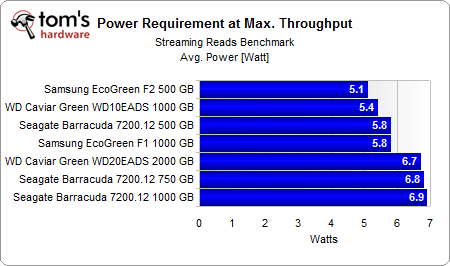New Desktop Hard Drives: Speed Or Capacity?
Power Consumption
WD’s WD10EADS remains the lowest-power 3.5” desktop hard drive. The new 2 TB drive requires 5.2 W and, hence, even more power than the 7,200 RPM Seagate Barracuda 7200.12 does due to its higher platter count of four versus two or one for the Seagate drives. It’s interesting to see that a single-platter Barracuda 7200.12 at 7,200 RPM consumes about the same amount of power at idle that the 5,400 RPM two-platter Samsung Spinpoint F2 EcoGreen does.
The power consumption increases at maximum sequential throughput. The low-power drives with few platters are the most efficient. Seagate’s Barracuda 7200.12 at 1 TB requires the most power, but is still not inefficient given its relatively high performance. Other drives require up to 10 W to do the same job.
Full HD Video playback also means sequential throughput, but with a limited data stream.
Workstation-type I/O creates a very different load, which primarily shows that a larger number of platters and heads translate into higher power consumption. However, the single-platter drives actually do not offer significantly lower power results in idle mode.
Get Tom's Hardware's best news and in-depth reviews, straight to your inbox.
Current page: Power Consumption
Prev Page PCMark Vantage Application Benchmark Next Page Noise And Temperature


